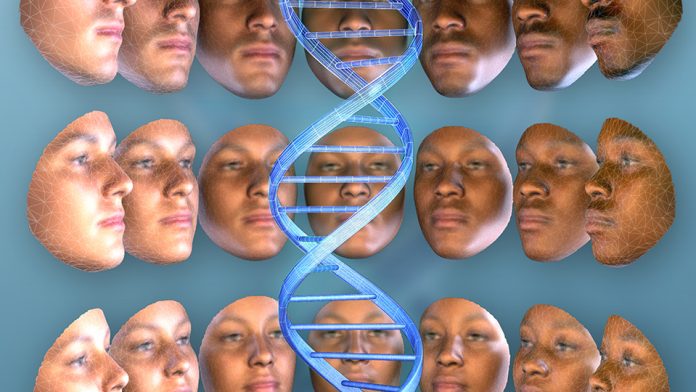Imagine a world where your genetic code—something you didn’t consent to share—becomes the basis for a digital mugshot. You’ve never been arrested, never given a facial photo, and yet, your DNA has been algorithmically morphed into a face that might resemble you just enough to get you stopped, questioned, or even incarcerated. This isn’t speculative fiction anymore. It’s happening now.
Law enforcement agencies in the U.S. are experimenting with combining DNA phenotyping and AI-driven facial recognition to generate suspect images. One key player, Parabon NanoLabs, uses machine learning to produce a “Snapshot Phenotype”—an AI-generated face based on traits inferred from DNA (like eye color, skin tone, and face shape) [¹]. In a troubling 2020 case, California detectives took such an AI-rendered face and fed it into facial recognition software to match it to real people [²].
Let’s pause here.
This is not science fiction. This is scientifically flawed.
The idea that you can reverse-engineer someone’s face from DNA alone has been widely criticized. Experts from the Stanford Center for Biomedical Ethics and American Society of Human Genetics have cautioned that phenotype predictions from DNA are probabilistic, not precise [³][⁴]. Even Parabon’s own materials admit that their renderings are speculative. In other words, these aren’t photos. They’re algorithmic guesstimates, dressed up in digital realism.
Now imagine taking that digitally guessed face and running it through facial recognition software, which itself has a documented history of bias against Black, brown, and nonbinary individuals [⁵]. You’re doubling down on errors. It’s statistical junk food: empty of nutritional accuracy but still capable of causing systemic harm. The risk of false arrests skyrockets—especially for people who “look like” the algorithmic face, which could be hundreds or thousands of people.
This practice is not only unreliable—it is a recipe for automated injustice.
Why It’s Dangerous
Using DNA to create facial reconstructions presents several critical issues:
- Scientific Inaccuracy: DNA cannot reliably predict facial morphology with high precision. The correlation is too weak and noisy [³].
- Compounded Bias: Feeding these speculative faces into face recognition tools introduces multiple layers of bias and uncertainty, especially given that these systems disproportionately misidentify people of color [⁵][⁶].
- Lack of Oversight: There are no binding federal regulations restricting this practice. Internal policies or terms of service are easily ignored or bypassed [⁷].
- Ethical Overreach: Individuals whose data is used (e.g., from genealogy databases) may not be aware that it’s being co-opted for policing. This breaches informed consent, a pillar of medical and scientific ethics.
AI-Assisted Photo Restoration for Forensic Use
Contrast this misuse with a more constructive use of AI: completing partially damaged or missing facial photographs in real investigations. AI image enhancement tools can use known visual information—such as blurry surveillance footage or damaged facial composites—to fill in missing segments, increasing clarity without inventing entirely new people.
This method is grounded in actual visual data, not speculative biology. If done responsibly, AI in this domain serves more like a digital magnifier, not a genetic fortune teller. When facts are present—such as 80% of a visible face—AI can help interpolate the remaining 20% using context. This is fundamentally different from conjuring a full image out of genetic guesses.
My Final Word
As someone who’s spent a lifetime working with technology and its practical solutions, I know appetite for the allure of cutting-edge AI. But with great algorithms come great responsibilities. Building faces from DNA is not only a dangerous fantasy—it’s digital phrenology, dressed up in machine learning.
We should always ask? Are we building technology that amplifies truth, or one that amplifies bias and speculation? Using AI to enhance existing photos is a technical solution rooted in known reality. Using AI to construct faces from DNA is a fiction that risks lives.
Let’s build systems that illuminate—not incriminate.
References
- Parabon NanoLabs – Snapshot DNA Phenotyping
- Distributed Denial of Secrets Leak on East Bay Police Use of Phenotyping
- Lippert et al. (2017). “Identification of individuals by trait prediction using whole-genome sequencing data.” PNAS. https://www.pnas.org/doi/10.1073/pnas.1711125114
- Worsnop et al. (2020). “The use of forensic DNA phenotyping in predicting appearance and ancestry.” Frontiers in Genetics.
- Garvie et al. (2016). “The Perpetual Line-Up.” Georgetown Law’s Center on Privacy & Technology. https://www.perpetuallineup.org/
- Buolamwini & Gebru (2018). “Gender Shades: Intersectional Accuracy Disparities in Commercial Gender Classification.” https://proceedings.mlr.press/v81/buolamwini18a.html
- EFF. (2023). “Face Recognition Technology Harms Civil Liberties.” https://www.eff.org/pages/face-recognition




